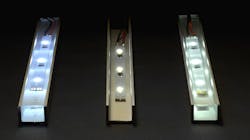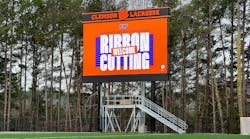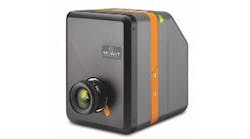While LEDs are generally quite simple to apply for the user, manufacturers are faced with two challenges when dealing with their production:
On the one hand, the conformal coating of luminescence conversion LEDs which is applied to ensure a reliable operation, brings about an undesired displacement from the original colour temperature towards cold white light of blueish appearance, referred to as the cold-light shift.
On the other hand, the operating heat which can be significant especially when using high power LEDs, needs to be dissipated in order to maintain the radiation power and to extend the lifespan.
Colour temperature management of LEDs by means of Jetset Solution
The colour temperature (CCT – Correlated Colour Temperature) of white LEDs is produced by luminescent colourants transforming a portion of the short-wave blue light into long-wave yellow light, in such a way that the additive colour mixing will give a white light (see top picture of figure 1: initial state).
http://www.peters.de/upload/news/2017/01/Fig1_CCT_Shift_en.png
Figure 1: Functioning of Jetset Solution
In the potting process, the colour temperature on the interface between the conversion layer/potting interface is displaced, due to physical influence, towards the short-wave blue area and will therefore appear colder (middle picture of figure 1: CCT shift – potted). The desired warm portion of the light provoked by its yellow portion will disappear (figure 2).
Subject to poor/irregular adhesion, this effect may be more or less intense, which will result in different colour temperatures. In order to achieve both a consistent colour temperature and a reliable protection, a homogeneous and good adhesion of the potting is indispensable.
http://www.peters.de/upload/news/2017/01/Fig2_spectrum.png
Figure 2: Spectrum of an LED in non-potted and potted condition and with Jetset Solution (nano-primed and potted)
Jetset Solution by Peters now provides a solution to control the cold-light shift effect: The ELPECAST® Nano Primer NP 4 LED is applied in a very thin layer on the LEDs, evenly and reproducibly, prior to potting. Once the solvent formulated has completely evaporated, a fine film will be left on the LEDs. Subsequent potting with a crystal-clear ELPECASTâcasting compound will prevent the shifting of the LEDs’ colour temperature and ensure an even result through optimum adhesion.
The solution causes repeated passage of the light through the conversion layer, which converts blue light portions into yellow ones (see figure 1 below: Jetset Solution).
(see photo attached)
Figure 3: Side view of LED strips:
Middle: initial state (non-potted), left: cold light shift, right: Jetset Solution
Depending on the quantity of primer applied, one can achieve a precise colour temperature as desired (figure 4). The quantity to be applied depends, amongst others, on the luminescent colourants present in the conversion layer, besides on the geometry, the surface, the performance and the initial colour temperature of the LEDs.
http://www.peters.de/upload/news/2017/01/Fig4_diagram.png
Figure 4: Colour temperature as a function of the quantity of primer applied
Thermal Management of LEDs: Thermal connection and thermo-mechanical decoupling with thermal interface paste and heatsink paste
Based on silicone resins, the ELPEPCB® Thermal Interface Paste TIP 2792 is applied on the interface between the printed circuit board and the heatsink or heat-dissipating casing. Thanks to its elasticity, it ensures a reliable thermal connection and improves the heat transfer and heat dissipation while the operating heat is efficiently lowered. Heat vias can be safely filled with this paste in view of enlarging the thermal interface.
http://www.peters.de/upload/news/2017/01/Fig5_classical_heat_transition.PNG
Figure 5: Classical heat transfer – microscopic air inclusions reduce the contact area and lower heat dissipation
http://www.peters.de/upload/news/2017/01/Fig6_heat_transition_TIP.PNG
Figure 6: Heat transfer with printed thermal interface paste such as the flexible Thermal Interface Paste TIP 2792
The white solder-resistant 1-pack paste is distinguished by excellent electrical insulation properties. Applied by screen printing in different structures and layer thicknesses, it is less costly than heat-conductive metal foils, for example, which have to be cut to fit their respective application.
Selective coating and curing is made at the PCB manufacturer’s site prior to soldering, on the bare printed circuit board in the desired layout. This way, the final user has the advantage of receiving the printed circuit boards ready with the TIP.
As an alternative, by using the ELPEPCB® heatsink pastes, one can fully dispense with heat-conductive metal sheets and thus reduce the number and size of thermal transfer resistances. Based on epoxy resins, these are highly heat-conductive, electrically insulating 1-pack screen printing inks which are considered a reliable alternative to commonly used cooling elements.
The heatsink pastes can be directly printed in heat vias and on the metal surfaces of the printed circuit board. Since there is no need for an insulating adhesive layer, the results are similar to those achieved with metal foils.
Moreover, it is possible to combine the two thermal interface pastes TIP 2792 and HSP 2740 in applications where very high insulation properties are required. In this case, HSP 2740 is printed in the heat vias and on the surfaces of the printed circuit board first, followed by the printing of TIP 2792 on top, in order to ensure a good connection to the heatsink.
Thanks to the higher thermal dissipation enabled on the bottom side of the pcb by combining TIP 2792 and HSP 2740, it was possible to increase not only its reliability, but also the lifespan of the individual components.
A thermal management aimed at a higher radiation performance of LEDs and a longer lifespan of assemblies and high power devices can be easily achieved through an efficient reduction of the operational heat by means of the Thermal Interface Paste TIP 2792, which can be combined, if necessary, with the Heatsink Paste HSP 2740. By the same token, electrical power failures are reduced and a higher lumen/Watt performance can be reached.
Jetset Solution and thermal interface pastes facilitate both the production and/or the management of LEDs as to colour temperature and heat.
Contact address:
Lackwerke Peters GmbH & Co. KG, Hooghe Weg 13, 47906 Kempen
Phone +49 2152 2009-0, Fax +49 2152 2009-70
Email: [email protected], www.peters.de
Come and visit us at Light + Buildung: hall 4.0, stand B40





